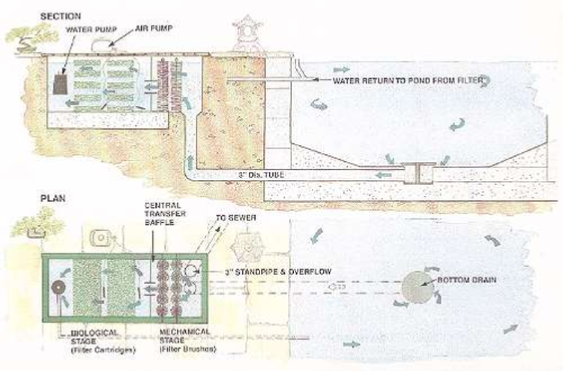Koi Pond Basics
If you have been bitten by the Koi bug and you have decided that you want some “swimming jewels” of your own, in a backyard pond, there are some things you should know and do before you start digging.
If you want to really enjoy a backyard water feature that includes Koi and Goldfish it is really important to understand that like any other pet keeping fish in a pond is a long term commitment. You cannot just dig a hole in the ground fill it with water and fish and expect any type of success or enjoyment.
We highly recommend that after you have made the decision to build a pond that you seek the consul of local Koi hobbyists, there are Koi Clubs all over the country, find a local club and seek their help. Many of the members of these Koi Clubs have built ponds and would be happy assist you so you don’t make the mistakes they did when they entered the hobby.
You can also seek the advise of Koi and Goldfish professionals, although the fact that they do make their living from supplying pond essentials and fish, be aware that there might be a consulting charge for their help.


If you are confident in your abilities as a DIY projects, here is a list of the things you should consider before you dig the first shovel load of dirt.
- Research, research. research… find out as much about Koi and Goldfish husbandry as possible, GOOGLE provides a wealth of information right at your fingertips.
- Decide on an approximate size, always build the largest pond that will fit your location because in this case Larger is BETTER! This entails going over your property survey so you don’t encroach on property lines or run into buried utilities.
- Understand how your pond will receive sunlight throughout the seasons. And make any special equipment plans, if you live in an area of the country that has harsh winters.
- Find out what the water table is on your property.
- Find out what your local ordinances are concerning Ponds.
- Enlist the advice of local Koi hobbyists because they have their own ponds they can answer many of these questions. This is important if you want to eliminate the costly mistakes that are very easy to make.
- Depending on your budget you must decide on what type of pond you are going to build i.e. a liner pond basically a hole with a rubberized liner, a concrete pond, completely in-ground, partially raised, prefabricated like some swimming pools. You must also decided a traditional style pond (mostly rectangular or free form as well as the theme of your pond i.e. Japanese, modern, garden, etc).
- Every Koi or Goldfish pond must be a self contained habitat. That means you need to provide clean water, and lots of it. You can cut down on the amount of clean fresh water by having a variety of filters. This includes mechanical filtration (filter mats, a bead filter, sand filter, cyclone filter this list is very long… and the sole purpose of any mechanical filter is to remove as many suspended solids in the water as possible)
- As part of this Habitat you will also need a biological filter. This is accomplished by nurturing the “good bacteria” that will colonize every nook and cranny of your pond and filter system. In essence this is the engine that converts all that fish waste into the stuff your pond plants will soak up and love! Read more about this process and overall water quality on this page.
- Some of the skills you will need to build a pond are excavating either by shovel or machine. Plumping there will be a lot of PVC pipe cutting, fitting and gluing. You will need to have some electrical help if you are going to run separate circuits to your pond to run the main pump, aeration pump and pond lights. Depending on you local codes you might have to hire a licensed electrician.
- You will have to know the Volume (Gallons) of water in your pond to select the appropriate size pump. You want to be able to turn your water “over” every couple of hours. More about pumps here.
- Plan on a minimum of 4 feet average depth of your pond. This gives your prized fish enough room to grow and if you are in an area where the water freezes, well it rarely will freeze below 2 foot. It also prevents predators wading around and making a meal of your fish!
- Plan on installing a surface skimmer to automatically remove any floating leaves and such. Read more here.
- Depending on the size of your pond you will and should have at least 1 bottom drain.
- Even if you have designed into your pond a water fall or stream an air pump is a valuable piece of equipment. It keeps the water circulating for better gas exchange and prevents stagnant pockets of water.
- Last but not least, for your enjoyment and the ability to see your fish in clear water, you will need a UV clarifier (filter). This apparatus kills the DNA in floating Algae cell preventing them from reproducing. Without a UV Light you will quickly have a “pea soup” pond and your fish will be virtually invisible!


